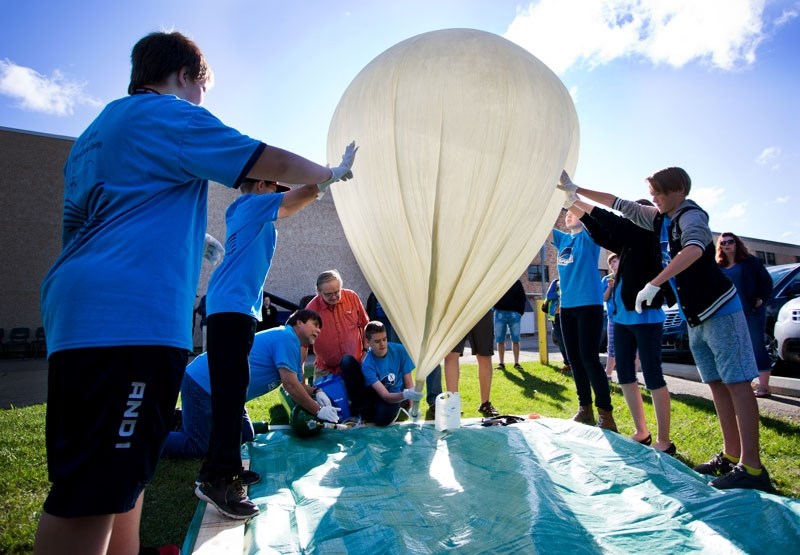St. Albert’s skies were full of balloons Friday morning as Sir George Simpson School celebrated the launch of the tenth SABLE space probe.
Hundreds of Simpson students assembled outside the school Friday morning to witness the launch of the SABLE 10 weather balloon/space probe.
The SABLE project is a school club led by teacher Tony Rafaat designed to give students hands-on science experience by manufacturing and launching a weather balloon probe.
As the crowd released a flotilla of smaller biodegradable balloons and the school band played Strauss’s Also sprach Zarathustra (a.k.a. the theme music from 2001: a Space Odyssey), Rafaat gave the signal to launch at 9:08 a.m. Student team members released the restraint strings and the probe leapt skyward.
This was the 10th probe launched as part of the St. Albert Balloon Launch Experiment and the seventh to take off from St. Albert, Rafaat said.
“This year is an exciting year,” he said, as the SABLE students are doing tasks they’ve never done before.
Rafaat said he started what was originally the Southern Alberta Balloon Launch Experiment back in 2006. Then a teacher at the Hand Hills Hutterite colony near Hanna, Alta., he’d read about a California man who had hooked a camera to a weather balloon and taken pictures of the Earth’s upper atmosphere. He teamed up with James Ewen and Barry Sloan of the Balloon Experiments in Amateur Radio (BEAR) team to attempt a similar feat with his students.
“When we did the first launch, it was terrible,” Rafaat said – howling winds plus insufficient helium meant the balloon spent all of 10 minutes airborne before it snagged in a tree.
SABLE 2 launched fine, but was never found as it’s radio beacon failed. SABLE 3 captured a perfect shot of the Earth from 117,597 feet (about four times the height of Mount Everest) on Aug 11, 2007, drew international attention, and got Rafaat onto the Discovery Channel to talk about it. SABLE 4 and onwards have all launched from Simpson.
This year’s launch went off without a hitch despite fierce winds. The balloon went from ground-bound white behemoth to tiny pearl in the sky in just minutes.
Dangling beneath it were three pink boxes containing the probe’s payload.
One box contained a programmable mini-computer called an Arduino hooked to several sensors, explained experiment designer and Simpson student Sam Craig.
“We have an accelerometer that tells us how fast we’re going, the magnetometer, which tells us the magnetic fields, and then we have the gyroscope which tells us the amount of spin we have.”
If it works, the sensors should help the team better track the probe’s rate of rise at different points in its flight, Craig said.
Mounted atop another box was a transparent pillbox containing eight candies.
This box is part of an experiment to test the effects of extreme UV radiation on the candies that the probe will experience as it approaches the edge of space, said experiment designer and student Jacob Cole.
The test candies are a caramel, chewed and unchewed gum, sugar-coated and plain gummy worms, new and old marshmallows, a Dutch mint, and a Skittle, Cole said. A GoPro camera will monitor the candies during their journey to track any changes.
Cole said he predicted that some of the candies might come back blackened, but doubted any would actually melt.
Also included in the probe are various cameras and a radio transponder.
SABLE 10 should reach an altitude of about 36.6 km in two hours before the weather balloon explodes, Rafaat said. High winds may cause it to move at up to 200 km/h relative to the ground as it ascends. If all goes well, the probe should touch down by parachute sometime around noon near Thorhild.
SABLE is a great way to learn about the scientific process and how to put together a project, Cole said. It also shows you that the sky really isn’t the limit, since there’s no limit to the sky but outer space.
“It’s something that never seems (to be something) you can do, yet you can do it. It’s really fun.”
The SABLE team was still searching for the probe as of press time.




